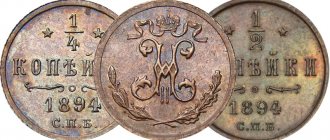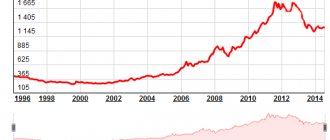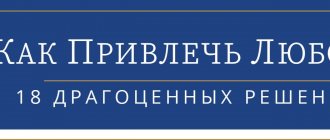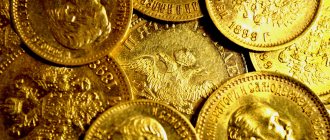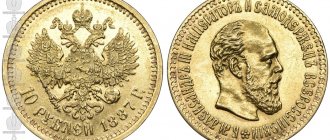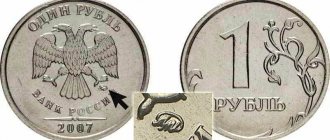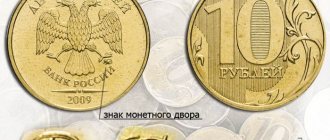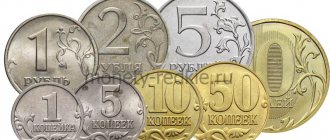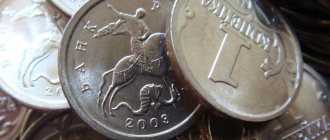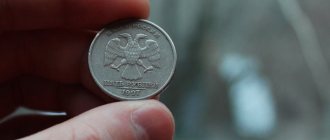Catalogs
→
Coins
With the coming to power of Peter I, the era of wire silver kopecks gradually ends. Since 1700, the production of copper coins of a normal round shape began, and then large silver denominations. The coins were in many ways similar to European ones: similar weight proportions were used, a coat of arms or other state symbol (St. George the Victorious) was placed on them, and a portrait of the ruler was depicted on high-denomination coins. The ruble becomes the basis of the monetary system, and the kopeck and its derivatives serve as small change. Gold is now a full-fledged participant in monetary circulation; chervonets and double chervonets are made from it - coins without denomination for internal and external large payments; gold 2 rubles also appear. After Peter I, the state of the coin system changed slightly (mainly only the weight of copper coins was affected); since the 19th century, new production technologies have been introduced, and coins gradually acquire a perfectly even shape and clear images. Gold 5 and 10 rubles were introduced during Elizabeth's reign.
Peter I Alekseevich (after the reform, 1700-1725)
Peter the Great became Tsar in 1682 along with his older brother Ivan. But until 1689, the government of the state was actually carried out by their sister, Sophia, until she was exiled to a monastery. Ivan did not take any part in politics, although until his death in 1696 he formally remained the legal ruler. After a long trip through Europe, Peter launched large-scale reforms in Russia, one of which was monetary reforms. Since 1700, copper coins in denominations of denga, half and half half came into circulation, then the copper penny appeared. Initially, they were minted in a foot of 20 rubles per pood. Soon, large round silver coins began to be minted in denominations: kryvennik (equal to 10 kopecks), ruble, half-ruble and half-fifty. Then a silver nickel and “ten money” of the same denomination are minted in limited quantities. The scale penny continued to be produced until 1718, with increasingly larger denominations being multiples of its weight. The new type of money was introduced gradually to avoid popular unrest. By the end of the Northern War in 1721, Peter proclaimed himself emperor, giving rise to a new era. In 1718, the date was put in the form of letters for the last time, and in 1723 copper 5 kopecks appeared (40 rubles per pood per foot), completing the monetary reform. Under Peter I, gold coins called chervonets came into circulation for the first time. Their exchange rate was floating (about 2 rubles), but the weight remained standard for a long time - 3.47 g. Double chervonets were also issued. This section contains information about coins minted after the beginning of the monetary reform. Pre-reform ones are presented here.
Peter the Great became Tsar in 1682 along with his older brother Ivan. But until 1689, the government of the state was actually carried out by their sister, Sophia, until she was exiled to a monastery. Ivan did not take any part in politics, although... (read more)
Number of coins: 367
Catherine I Alekseevna (1725-1727)
After the death of Peter I in 1725, his second wife, Catherine, ascended the throne, since no heir lived to see this time. There are many versions about the origin of Catherine (before accepting Orthodoxy she was Martha), but it is known that she had Baltic roots. Rules for only two years, while power mainly belonged to A.D. Menshikov and the Supreme Privy Council. Of the copper coins under Catherine I, only 5 kopecks were minted; there were also silver hryvnia (10 kopecks), half and ruble.
After the death of Peter I in 1725, his second wife, Catherine, ascended the throne, since no heir lived to see this time. There are many versions about the origin of Catherine (before accepting Orthodoxy she was Martha), but it is known that about... (read more)
Number of coins: 43
Peter II Alekseevich (1727-1730)
Pyotr Alekseevich ascended the throne at the age of 11. He was the grandson of Peter the Great (son of Alexei Petrovich) and the son of a German princess. He was the last direct representative of the Romanov dynasty in the male line. As under Catherine I, power was in the hands of Menshikov, then the Dolgorukov princes. In 1728, the capital was again moved to Moscow, but already in 1730 it was returned to St. Petersburg. Under Peter II, the same coin denominations were minted as under Catherine (5 kopecks, ruble, half and ten kopecks), but gold chervonets were also produced to a limited extent.
Pyotr Alekseevich ascended the throne at the age of 11. He was the grandson of Peter the Great (son of Alexei Petrovich) and the son of a German princess. He was the last direct representative of the Romanov dynasty in the male line. As under Catherine I, the ruler... (read more)
Number of coins: 24
Anna Ioannovna (1730-1740)
Peter II lived to be only 14 years old, after him Anna Ioannovna, the daughter of Ivan V, brother of Peter the Great, ascended the throne. From 1710 she lived in Courland with her husband, but in 1730 she was invited as a monarch while maintaining the power of the Supreme Council, this was the initiative of Prince Golitsyn. Anna immediately dissolved the Council and became an autocratic empress. It is believed that during her 10-year reign, a significant part of the power belonged to Biron, but there is still no evidence of this. Anna Ioannovna managed to carry out several reforms, which became a continuation of the interrupted policies of Peter the Great. Coin production is significantly intensified, polushka and denga are minted from copper in the foot of 10 rubles per pood, from silver - ruble, half, half-half and ten-kopeck coins. Only chervonets were produced from gold coins. In 1731, part of the copper coins of Peter I and Peter II were minted into dengi and half rubles, first in steps of 10 rubles per pood, then 5 rubles per pood, and from 1734 again 10 rubles per pood
Peter II lived to be only 14 years old, after him Anna Ioannovna, the daughter of Ivan V, brother of Peter the Great, ascended the throne. From 1710 she lived in Courland with her husband, but in 1730 she was invited as a monarch while maintaining the power of the Supreme Council... (read more)
Number of coins: 83
Ivan VI (III) Antonovich (1740-1741)
In 1740, according to the will of Anna Ioannovna, two-month-old Ivan, the great-grandson of Ivan V, formally became emperor. The state at that time was ruled first by Biron, and then by the mother of Ivan VI, Anna Leopoldovna. In 1741, the future Empress Elizabeth sent Ivan to prison, where he spent 23 years until he was killed. In this short period of time, an attempt was made to establish the production of coins with a portrait of Ivan VI (where his age was slightly overestimated). Now such coins are considered very rare. In some catalogs and reference books, Ivan VI is called Ivan III according to the terminology of pre-revolutionary times (the account was kept from Ivan the Terrible, not Ivan Kalita), the same designation on silver coins of his reign.
In 1740, according to the will of Anna Ioannovna, two-month-old Ivan, the great-grandson of Ivan V, formally became emperor. The state at that time was ruled first by Biron, and then by the mother of Ivan VI, Anna Leopoldovna. In 1741, the future Empress Elizabeth o... (read more)
Number of coins: 12
Elizaveta Petrovna (1741-1761)
Since 1730, the ruling elite was constantly under pressure from the heirs of Peter the Great. Taking advantage of the decline in the authority of Anna Leopoldovna, who ruled for the young Ivan VI, supporters of Elizaveta Petrovna (daughter of Peter I) organized a palace coup. Elizabeth I continued the policies of her father, carried out large-scale reforms in the field of education and theatrical arts, but at the same time became famous for her very lavish celebrations and balls. Her wardrobe consisted of several thousand dresses. From 1757, the copper coin stock increased to 16 rubles per pood and coins began to be minted, almost unchanged until 1796. At the same time, several types of test coins appeared, now considered rarities. Several samples were also produced in gold coinage. A ruble, 2 rubles, and 20 rubles are added to the chervonets and double chervonets, and the minting of the imperial (10 rubles) and half-imperial (5 rubles) begins.
Since 1730, the ruling elite was constantly under pressure from the heirs of Peter the Great. Taking advantage of the decline in the authority of Anna Leopoldovna, who ruled for the young Ivan VI, supporters of Elizaveta Petrovna (daughter of Peter I) organ... (read more)
Number of coins: 283
Peter III Fedorovich (1761-1762)
After the death of Elizabeth there was a short reign of Peter III (initially called Karl), the grandson of Peter the Great (son of Anna's daughter). Born and lived in Sweden and was initially raised as heir to the Swedish throne. In 1742, Elizabeth transported him to Russia, where three years later he married Catherine, the future empress. Peter ruled for only 186 days, but during this time he managed to carry out several important reforms. Under Peter III, several denominations of coins with a portrait of the emperor were minted in limited editions in silver and gold. The emperor also carried out a massive reminting of old-style copper coins into new ones with a 2-fold increase in denomination; the project was conceived back in 1760.
After the death of Elizabeth there was a short reign of Peter III (initially called Karl), the grandson of Peter the Great (son of Anna's daughter). Born and lived in Sweden and was initially raised as heir to the Swedish throne. In 1742, Elizabeth transported him to R... (read more)
Number of coins: 18
Catherine II Alekseevna (1762-1796)
In the summer of 1762, a palace coup took place, after which the wife of the former emperor, Catherine, ascended the throne. Peter III himself was soon killed. Catherine came from a German family and had no ancestors from the Romanov dynasty. She ruled for 34 years, this period is considered the “golden age” of the Russian Empire. For her enormous achievements in domestic and foreign policy, she subsequently received the title of Great. Under it, the most significant stratification of society occurs, the nobles receive great privileges. Great successes are being achieved in the cultural development of the country, priceless masterpieces of painting are being brought from Europe, and museums are being created. Copper coins continue to be minted according to the previous pattern with the design of the 1757 sample, but with the monogram of Catherine II. Reminting of lightweight coins of the 1762 model with the image of military fittings begins, with the denomination halved. Only the half piece was not recoined because it was too small. In 1796, by order of Zubov, the coins in circulation were re-minted into new ones (“monograms”), with their weight halved. Under Paul I, these new coins were reversed into coins with the dates 1791-1796. On some specimens you can see traces of 2-3 images. In addition, Moldavian coins were re-minted, but they can only be recognized by their patterned edge. From 1763 to 1781, much lighter “Siberian coins” were minted from copper from the Kolyvan mines, which contained an admixture of gold and silver. For the first time in history, silver coins in denominations of 20 and 15 kopecks are minted. Test silver 5 kopecks and test “Pugachev” rubles are also known.
In the summer of 1762, a palace coup took place, after which the wife of the former emperor, Catherine, ascended the throne. Peter III himself was soon killed. Catherine came from a German family and had no ancestors from the Romanov dynasty. She ruled on the 34th... (read more)
Number of coins: 677
Pavel I Petrovich (1796-1801)
The son of Catherine II and Peter III ascended the throne at the age of 41. He carried out a large number of reforms that weakened the position of the nobility and improved the situation of the peasants. To avoid revolution, he banned the import of foreign literature and education abroad. He actively fought the nascent French Empire, changed the order of succession to the throne (after him, power was transferred from father to son). In 1798 he was proclaimed Master of the Order of Malta, after which difficult relations with Britain began (Malta was part of it). It is believed that it was representatives of Britain who organized the murder of Paul in 1801. At the beginning of the reign of Paul I, copper coins of a new type, introduced by Catherine II, were re-minted. They exactly repeated the coins of the 1763 model and had the monogram of Catherine II. This was done in connection with the return of the old foot (16 rubles per pood). Since 1797, coins with the monogram of Paul I have been minted in denominations from half a half to 2 kopecks. Silver 5 kopecks repeated their design, and large coins (ruble, half and half-fifty) had a monogram of four letters “P” on the front side and with an inscription on the back (since 1798 their weight was reduced). A test silver efimok is also known. 5 rubles and a chervonets were minted from gold coins, which were then abolished.
The son of Catherine II and Peter III ascended the throne at the age of 41. He carried out a large number of reforms that weakened the position of the nobility and improved the situation of the peasants. To avoid revolution, he banned the import of foreign literature and educational... (read more)
Number of coins: 96
Alexander I Pavlovich (1801-1825)
At the beginning of his reign, Alexander I refused to inherit the Order of Malta, thus improving relations with England. Under him, several significant wars of the 19th century took place, as well as victory in the Patriotic War of 1812. Finland, Bessarabia, Poland and Eastern Georgia were annexed. Several internal reforms were also carried out, but did not have a significant impact on the political structure of the country. Since the 1810s, an opposition movement has been growing, which in 1825 led to the Decembrist uprising - the first revolution against the autocracy. Since 1802, the design of copper coins has changed, and since 1810 there has been a significant reduction in their weight. Copper 5 kopecks have been reintroduced, but at the same time a silver coin is also being issued. The remaining denominations only had a different design. Gold chervonets are also being abolished, giving way to coins in denominations of 5 and 10 rubles, popularly called imperials and semi-imperials.
At the beginning of his reign, Alexander I refused to inherit the Order of Malta, thus improving relations with England. Under him, several significant wars of the 19th century took place, as well as victory in the Patriotic War of 1812. Was joined... (read more)
Number of coins: 355
Nicholas I Pavlovich (1825-1855)
The heir was to be Alexander I's elder brother, Constantine, who back in 1820 announced his intention to abdicate the throne in favor of his younger brother, Nicholas. Nikolai found out about this only a few days after his brother’s death, having already sworn allegiance to Constantine. During this period of interregnum, several copies of trial rubles with a portrait of Constantine were issued, which are now considered a numismatic rarity. Taking advantage of the confusion of the interregnum, the Decembrists organized an uprising against the autocracy, but the revolution was suppressed on the same day. Under Nicholas I, wars with Persia and Turkey continued, and the Crimean War began. The first railway in Russia was opened, and in 1851 a road was built from St. Petersburg to Moscow. From 1839 to 1843, under the leadership of E.F. Kankrin carried out a monetary reform, during which the silver ruble became the main unit, the remaining coins and paper notes were to be a secondary means of payment. For a gradual transition to the new system, until 1848 the denomination of copper coins was denoted in silver, and the foot was lowered to 16 rubles per pood. Then the weight decreases by 3 times and the change coins begin to have only a nominal value.
The heir was to be Alexander I's elder brother, Constantine, who back in 1820 announced his intention to abdicate the throne in favor of his younger brother, Nicholas. Nikolai found out about this only a few days after his brother’s death, having already… (read more)
Number of coins: 584
Alexander II Nikolaevich (1855-1881)
The reign of Alexander II was associated with the most important reforms that significantly transformed the internal situation in the country. In 1861, serfdom was abolished, then financial reform was carried out, laying the foundations of a capitalist economy. Military settlements have been liquidated. Uprisings in different regions of the country led to a more thoughtful organization of the internal political system. At the end of the reign, a reform was prepared to limit autocracy. All this earned the emperor the title “Liberator.” Great successes were also achieved in foreign policy: Central Asia and Turkestan, the North Caucasus, Transbaikalia, the Far East, Bessarabia, and part of Georgia were annexed. The Crimean War is over. At the end of the 1870s, the last Russian-Turkish war took place, after which peace was finally concluded with the Ottoman Empire. In 1867, due to economic unprofitability, Alaska was sold to the United States. Since 1867, the weight of copper coins has once again been reduced, which from that time were minted without changes for 50 years until the Revolution (only the monogram changed). Since 1859, the design of silver coins has changed, which will also remain almost unchanged in the future. A gold coin with a face value of 3 rubles appears.
The reign of Alexander II was associated with the most important reforms that significantly transformed the internal situation in the country. In 1861, serfdom was abolished, then financial reform was carried out, laying the foundations of a capitalist economy. L... (read more)
Number of coins: 526
Alexander III Alexandrovich (1881-1894)
After the assassination of Alexander II, his son, Alexander III, ascended the throne. Under him, the Russification of the newly annexed territories was carried out. New reforms, called “counter-reforms,” were carried out, during which all power was returned to the emperor, but at the same time the life of the peasants improved. Despite this, it became increasingly difficult to contain the unrest of the popular masses; revolutionary movements arose in different parts of the empire. In 1887, an attempt was made on the life of the emperor, one of the organizers of which was brother V.I. Lenin. A period of calm began in foreign policy, military alliances against other countries ceased, and Russia strengthened its prestige. The minting of gold coins with a face value of 10 rubles began again, while 3 and 5 rubles continued to be produced. On the remaining denominations, only the monogram has changed. In 1882, there was an attempt to replace copper coins with copper-nickel coins of much lighter weight, but the idea was abandoned until better times.
After the assassination of Alexander II, his son, Alexander III, ascended the throne. Under him, the Russification of the newly annexed territories was carried out. New reforms were carried out, called “counter-reforms”, during which the full power of the emperor was returned... (read more)
Number of coins: 196
Nicholas II Alexandrovich (1894-1917)
The reign of Nicholas II went down in history as a very turbulent period. The revolutionary movements that originated under Alexander III gained strength until they led to the Revolution of 1905. This time the uprising was suppressed. To avoid new unrest, several reforms were adopted regarding freedom of religion, freedom of speech and the establishment of the State Duma. But all this only contributed to the strengthening of popular movements. In 1914, new interstate alliances led to Russia's entry into the First World War. The opposition took advantage of the weakening of the economy and power, and at the beginning of 1917 the February Revolution took place, during which Nicholas II abdicated the throne. In March, the Provisional Government came to power. A year and a half later, in July 1918, the emperor was shot in Yekaterinburg along with his family. There were also many changes in the coinage of this time. In 1895-1898, a monetary reform was carried out under the leadership of S.Yu. Witte, during which the gold ruble became the basis of monetary circulation (before that, silver was considered the main one). The weight of gold coins is reduced by one and a half times. In 1897, coins of the old weight were minted for the last time, but with an increased denomination (15 and 7.5 rubles). In 1915-1916, due to the difficult economic situation, it was planned to introduce lightweight copper-nickel coins in denominations from 3 to 25 kopecks; lower denominations were to remain copper, but one and a half times lighter. The issue of introducing steel money was even considered. All developed versions remained trial ones and are now highly valued among collectors.
The reign of Nicholas II went down in history as a very turbulent period. The revolutionary movements that originated under Alexander III gained strength until they led to the Revolution of 1905. This time the uprising was suppressed. To avoid new... (read more)
Number of coins: 326
TOP 5 most expensive Russian gold coins dealer Zolotoy Zapas
As an example of the most expensive money produced by Russian mints, several samples can be cited, which will be described below.
Coin for the 150th anniversary of the Bank of Russia 50,000 rubles
It contains 5,000 grams of gold and was produced for the 150th anniversary of the Bank of Russia, which was established in 1860.
For its manufacture, 999 precious metal was used. The technology is proof-like.
This expensive Russian gold coin was produced by SPMD in 2010.
It is characterized by a diameter of 130.0 millimeters and a thickness of 23.0 millimeters.
A total of 50 copies were made.
Commemorative gold coin “Moose. Let's save our world" with a denomination of 10,000 rubles
To make the “Elk” coin, 1 kilogram of gold with a “three-nines” hallmark was used.
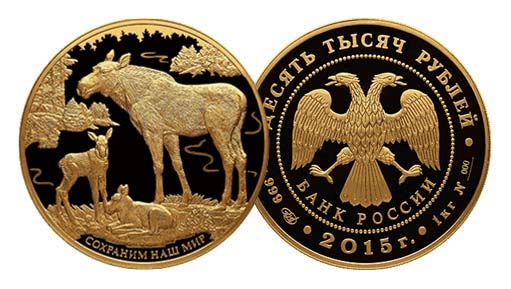
This expensive coin is part of the “Save Our World” series, dedicated to the protection of the unique Russian nature.
The product is characterized by size 100.0 and thickness 8.5 millimeters.
It is minted in proof quality with a highly detailed design.
The manufacturer was the St. Petersburg Mint. The circulation was 25 pieces.
Commemorative gold coin of the Russian Bank, dedicated to the icon painter Andrei Rublev, with a nominal value of 10,000 rubles
The coin “Andrey Rublev” 1 kg of gold was produced at the Moscow Mint in 2007.

The product could be purchased from May 31st.
The publication complemented the numismatic cycle dedicated to the Russian creators of icons - Theophanes the Greek and Dionysius.
This prized coin is struck from 999 purity gold metal and is limited to just 100 pieces.
It has dimensions of 100.0, a thickness of 8.5 millimeters and a weight of 32.2 troy ounces.
Commemorative coin issued by the Bank of Russia for the 60th anniversary of Victory in the Great Patriotic War of 1941-1945 with a face value of 10,000 rubles
Another most expensive coin for the 60th anniversary of the Victory was produced in Moscow as part of a set dedicated to the anniversary of the end of the war with Germany.

For its production, gold with a hallmark of “three nines” weighing 1000 grams was used. The product is characterized by a diameter of 100.0 and a thickness of 8.5 millimeters. The circulation was as much as 250 copies. The declared quality of the coinage is Proof.
Commemorative gold coin for the 300th anniversary of the annexation of Khakassia to Russia with a nominal value of 10,000 rubles
The golden “Khakassia” was also made at MMD in 2007. Contains 1 kilogram of gold with a purity of 999 and is included in the collection set. Its characteristics are similar to the previous copy.
The difference lies in the minting technology, which this time complied with the Proof-like standard. The release took place in a limited edition of 100 copies.
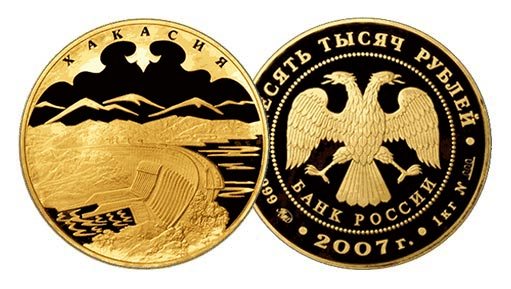
Review
The list of the most expensive coins from the times of the Russian Empire includes more than 10 items:
1) Polish thaler: this name was given to a coin with a face value of 1 ruble, minted in 1705. In fact, it is a copy of a Polish thaler dated 1630. The history of the appearance of such a coin is as follows: in 1704, by decree of Tsar Peter the Great, coins made of pure silver were issued. But in the eighteenth century there was a shortage of this precious metal in Russia, so it had to be imported (in the form of coins). The 1 ruble coin 1705 was re-minted from the Polish thaler, but the date “1630” was not redone, which is why the copy was considered defective. One numismatist purchased a thaler for 1.5 million rubles, while a similar ruble with a correctly minted date was sold for 3 times cheaper.
2) 1 kopeck 1726: expensive copper coins include this example. It is notable for its non-standard shape. The coin weighs 16 grams and its side length is 23 mm. Not long ago it was sold for 2 million rubles in Moscow. By the way, in the period from 1725 to 1727, square coins were minted and introduced into mass circulation.
3) 1 ruble 1730: this coin is called “Anna with a chain”. It was minted in the year of Anna's ascension to the throne of the empire. The ruble coin is made of pure silver. The “face” of the coin is decorated with a portrait of the ruler, and the reverse is decorated with the coat of arms of the empire. Today there are 3 original coins in the world. One of these originals was sold for 700 thousand dollars to an American collector.
4) 20 rubles in 1755: the release of two such coins marked the beginning of monetary reform in the empire. One was transferred for storage to the Hermitage, and the second 8 years ago in London was bought at auction for 1.5 million pounds sterling (plus about 200 thousand pounds of commission). Nowadays this is the most expensive coin of Tsarist Russia, kept by a numismatist.
5) Konstantinovsky ruble (1 ruble 1825): known not only for its high cost, but also for its extraordinary “biography”.
In 1825, Emperor Alexander the First died. Since the ruler had no heirs, the throne passed to Konstantin Pavlovich, Alexander’s brother. But 6 years before the death of the emperor, Constantine refused to inherit the throne, and only his closest relatives (mother and brother) knew about his decision.
In 1823, Alexander drew up a Manifesto, according to which, after his death, his third brother Nikolai Pavlovich was to become ruler. The manifesto was classified and could only be opened after Alexander’s death. A few hours after the death of the ruler, the document was opened and read out in the State Council. But, since information about Constantine’s renunciation of the throne was not disclosed, confusion arose - the guard and Nikolai Pavlovich himself swore allegiance to Constantine. He himself had been living in Warsaw for 10 years, so after the death of Alexander, together with his other younger brother Mikhail, he sent a message to St. Petersburg, which talked about abdicating the throne.
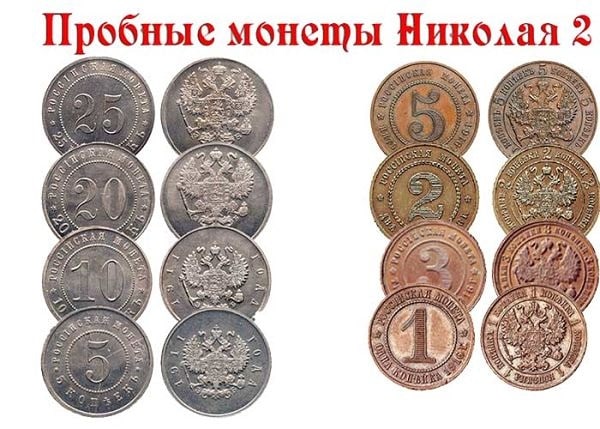
Trial coins of Nicholas II
While the message was being sent, the subjects of the empire were in bewilderment, because in 2 weeks the name of the new emperor had not been clarified. At the same time, the process of creating sketches and directly producing coins with the image of the new emperor (Constantine) was organized at the St. Petersburg Mint. But already in December 1825, Nicholas the First became emperor, but the soldiers and the secret community of Decembrists, believing that Nicholas had illegally taken power from Constantine, rebelled. The rebels advocated the abolition of serfdom, the abolition of the monarchy and the murder of the new emperor. Soon the rebellion was suppressed and the leaders were repressed. In this regard, the Minister of Finance ordered the immediate destruction of all 6 copies of new coins with the image of Constantine (the minister feared for his fate).
However, the coins were hidden from everyone, after which they were sent for storage to the Ministry of Finance of St. Petersburg until the transfer of the throne to Alexander II. But already in 1878, by order of the emperor, all 5 coins (the sixth disappeared under unknown circumstances) were distributed among members of the imperial family. Nowadays, several copies of these coins are part of private collections outside of Russia, one is in the Smithsonian Institution in the USA, two are in Russian museums. One of the numismatists purchased a Konstantinovsky ruble for 100 US dollars.
6) 12 rubles, dated 1836: 11 coins made of pure platinum were minted this year. The remaining known platinum coins were minted by order of numismatists, but they are copies. But the cost of originals is constantly growing. For example, in the capital of Great Britain, at one of the auctions, a twelve-ruble coin was given for an amount equivalent to 4.64 million rubles.
7) 1 ruble 1861: the circulation of these coins consists of 70 thousand copies, but the value of one such copy is quite high. For example, 5 years ago one such ruble was purchased by a numismatist for 1.4 million rubles.


9) 25 rubles 1908: in Siberia at the beginning of the last century, a unique creation of nature was mined - a gold nugget, the mass of which reached 5 kilograms. In honor of this, 2 coins were issued from pure gold taken from the find. Such coins were intended as souvenirs for members of the royal family. In 2011, one such coin passed into the hands of a private collector for almost 2 million rubles.
10) 5 kopecks 1916: were put into circulation during the First World War. Then the empire faced a problem - reserves of precious metals were running out. For this reason, the production of light copper coins was started, which would replace money made from precious metals. But due to the revolution of 1917, several pieces of these copper “nickels” came into circulation. 10 years after the revolution, copies of several copper coins were made at the orders of collectors.
These specimens are valuable and expensive. For example, several years ago one Russian collector purchased 5 copper kopecks for 1.6 million rubles.
Why buy the most expensive gold coins?
In addition to the cost of the precious metal itself, from which the most expensive gold coins in Russia are made, their price includes the so-called premium price for rarity, exclusive sizes and unique manufacturing methods. It can range from 4.3% for commemorative coins such as “Khakassia”, to 50-90% (and even over 100%) for collectible rare coins such as “Moose”. The cost of such copies is also formed based on the costs of production, transportation, insurance, advertising, etc. As a result, such products can turn out to be a profitable means of investing and preserving capital, since over the years this markup will only increase. Here it is important to monitor quotes, stay informed and understand which coins may have profitability in the future.
to the list
Other
The list of expensive coins of the Russian Empire described above is incomplete, because there are many more such coins. For example, a popular coin among collectors is the Sestroretsk ruble, associated with the era of the reign of Catherine the Great. The coins had unusually large parameters, and they were made of copper. The Sestroretsk ruble served as security for paper notes. The weight of such a coin reached one kilogram, so special equipment was needed to mint such copies. The design of the machines took at least nine months.
Attempts to establish a full circulation of Sestroretsk rubles took another 3 years, but in the end they turned out to be unsuccessful, and all because of the large dimensions of the coins and the unprofitability of their production. The original Sestroretsk ruble cannot be found on sale, since these coins have already found their owners.
Nowadays, buying coins of the Russian Empire is a full-fledged type of entrepreneurial activity. Even though the most valuable collectibles have already found their owner, numismatists still continue to find valuable coins from that period. This is what scammers take advantage of, offering numismatists counterfeits of these items. To avoid falling for the tricks of scammers, it is recommended to participate in large auctions where valuable coins and awards are sold. For those who sell coins, it is important to remember that the price of rare coins is always rising, so there is no need to rush to sell them.
Copper coins
As a rule, copper coins are not particularly in demand at numismatic auctions due to their low cost, but there are a number of exceptions - rare specimens.
1 kopeck 1726

The modest copper penny attracts the attention of numismatists for two reasons: an incredibly small circulation and an unusual shape for a coin - square. Since during that difficult period the empire was going through difficult financial times, it was decided to use inexpensive Ural copper for minting coins. It is noteworthy that the weight of some copper kopecks issued in 1826 reached the incredible weight of 1636. To date, numismatists know of only a dozen such unusual copper kopecks. Any of these copies is estimated at approximately 2 million rubles, which is an incredible amount for such banknotes.
Copper 1916 (5 kopecks)
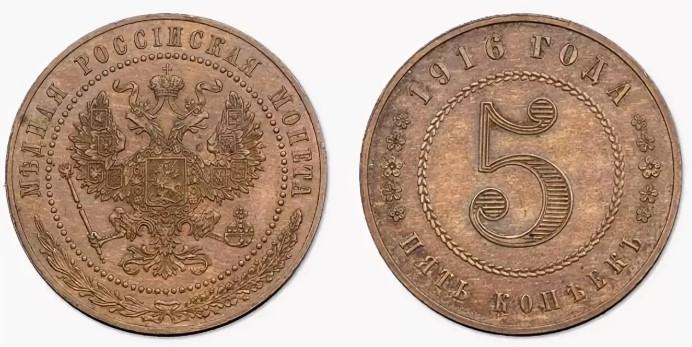
The last of its kind “representative” of the tsarist era. The copper was issued in a trial edition with one single purpose - to create liquid, inexpensive money. Such a desperate step was taken due to significant difficulties in the financial sector. And this is not surprising, because the treasury was practically emptied by the bloody war that had not yet ended at that time - the ruble depreciated. In fact, the copper became the last coin to feature the imperial coat of arms on the reverse—the revolution soon began. And, although copper coins quite rarely receive the honor of being sold at auction at a high price, the copper coin was an exception - the price of one copy reaches 1.5 million rubles.
2 kopecks 1740
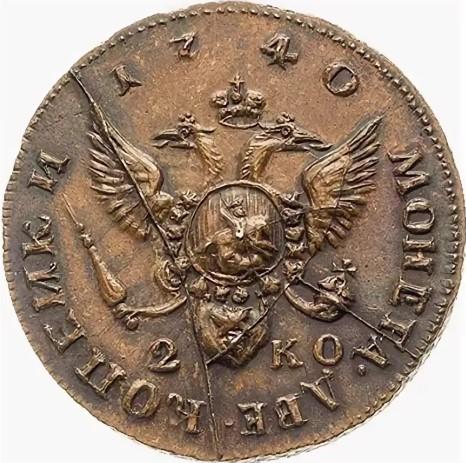
We are talking about coins from the time of Peter I, which were in use during the reign of his niece, Anna Ioannovna. At that time, their nominal value was quite high (more costs for minting), which could not but worry the empress, since a significant number of counterfeits came into circulation. Anna decided to withdraw the coins from circulation and melt them into two-kopeck coins. But the idea remained unrealized due to the death of the empress. But the trial minting of coins still remained. Only 6 copies have survived to this day (at least, that many are known at the moment). The cost of the last coin sold was about 4 million rubles.
Silver coins
Royal silver coins are distinguished by a variety of designs and small series of issues. Among such products there are also very rare, valuable specimens.
1 ruble 1730

Of course, the so-called “Anna with a chain” can be considered one of the most expensive silver coins of the period of Tsarist Russia. Thus, at an auction in 2007, a ruble copy with a “chain” was sold for more than 700 thousand dollars. In 1730, in honor of the niece of Peter I, Anna Ioannovna, who had just become empress, a small batch of silver coins was minted (only a few copies). The peculiarity of these banknotes is in the image on the reverse: it is unusual to see the imperial coat of arms surrounded by the chain of the Order of St. Andrew the First-Called.
"Konstantinovsky" ruble 1825
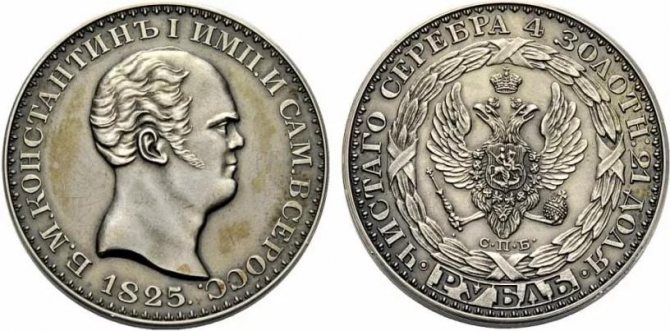
Created almost two centuries ago, the gold ruble is considered unique not only because it is one of the rarest and, accordingly, expensive banknotes of its era. The fact is that its obverse depicts a portrait of the imperial nephew, Konstantin Pavlovich, who was supposed to become the new heir to the throne, but this was not destined to happen.
The embarrassment was that within a week after the death of Nicholas I, the entire St. Petersburg nobility swore allegiance to the new emperor (whom the nephew of the deceased was supposed to become heir to the throne by seniority). And only after some time it became known that Konstantin Pavlovich at one time renounced the throne. During this short period, the mint managed to mint a small batch of coins. One of the copies of the “Konstantinovsky” ruble was sold for more than 35 million rubles.
